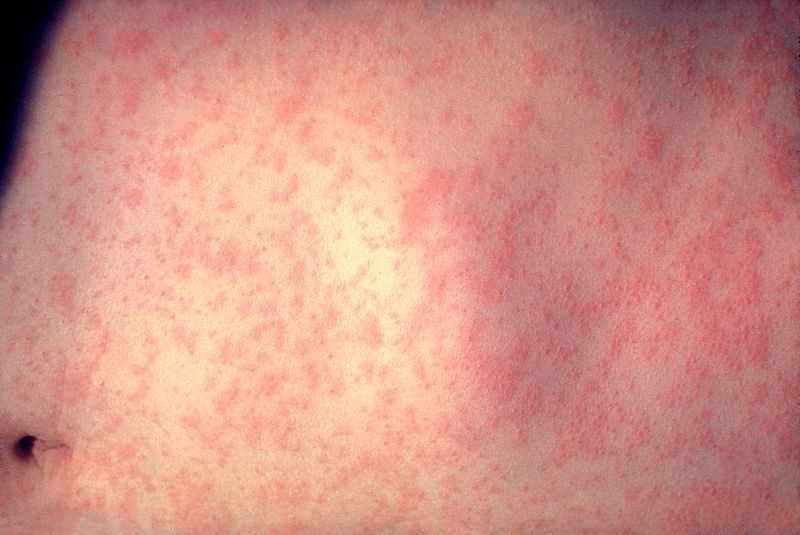Measles case confirmed in Moscow
Hospital staff quarantined infected individual, identified those exposed to virus
Anyone who believes they could have measles should self-quarantine, according to a statement from the Gritman Medical Center in Moscow.
June 5, 2019
Gritman Medical Center in Moscow treated a patient infected with measles Friday May 31, according to a statement on Gritman Medical Center’s website. This is the first confirmed case in Idaho since 2001, according to a press release from Public Health – Idaho North Central District (PH-INCD) sent Wednesday June 5.
Clinical staff at Gritman quickly recognized measles symptoms and isolated the infected individual in a negative pressure containment room to reduce risk of measles spreading, according to the hospital’s statement. After contacting the public health department, the patient left Gritman and staff cleaned all areas the individual passed through.
Public Health, the Idaho Department of Health and Welfare, and Gritman Medical Center are collaborating in response to the case, according to Public Health’s release. The hospital and Public Health identified people who could have been exposed to the virus, according to the statement.
Gritman’s statement recommended that all unvaccinated people who visited Gritman from 11 a.m. to 2:30 p.m. Friday May 31 contact Public Health.
To prevent a measles outbreak, all children and adults who can get vaccinated should get the vaccine, according to Public Health.
“If you think you or someone you know may have measles, it is extremely important that you self-quarantine at home to prevent spreading the virus,” Gritman’s statement said. “Do not go to public spaces or interact with others. Do not go to the hospital or doctor’s office. Call your doctor or clinic to get instructions or advice.”
A Washington’s measles outbreak in February and March was mostly confined to Clark County and a later outbreak in three Puget Sound counties began May 9, likely due to exposure at the Seattle-Tacoma International Airport, according to the Washington State Department of Health website. Fifty-two of the 81 cases reported in Washington affected people aged one to 10, according to the Washington DOH and sixty-three of the 81 confirmed infected individuals had received zero doses of the measles vaccination.











Tod Merley • Jun 11, 2019 at 2:38 pm
Note: Updated with the proper reference to the Idaho Department of Health
“A Strained Response to the Gritman Measles Diagnosis”
Gritman Medical Center, Idaho Department of Health and Welfare, and the Centers for Disease Control I do have a little question. Which strain of the measles virus was involved in this “measles” infection? During a recent reading of the MMRII vaccine package insert I believe I did see that all of the symptoms of measles were mentioned in the “ADVERSE REACTIONS” section. As well I read that “measles like illness” from the measles vaccine live virus strain has been documented in the medical literature. So perhaps the person was infected by another person who had been recently “artificially inoculated” through a live virus MMRII shot? Perhaps the older MMR shot had worn off or the older MMR strain was not close enough to that of the MMRII.
If it was a “wild” strain then I would love to see a genealogical genomic study giving us a good idea of where this strain did come from. Did the pressure of using live virus artificial inoculation attempt medical products pressure a wild strain to become what it is today or did the older MMR shot live vaccine virus become a new “wild” strain? Please do let us know.
Tod Merley • Jun 11, 2019 at 2:14 pm
“A Strained Response to the Gritman Measles Diagnosis”
Gritman Medical Center, Washington State Department of Health, and the Centers for Disease Control I do have a little question. Which strain of the measles virus was involved in this “measles” infection? During a recent reading of the MMRII vaccine package insert I believe I did see that all of the symptoms of measles were mentioned in the “ADVERSE REACTIONS” section. As well I read that “measles like illness” from the measles vaccine live virus strain has been documented in the medical literature. So perhaps the person was infected by another person who had been recently “artificially inoculated” through a live virus MMRII shot? Perhaps the older MMR shot had worn off or the older MMR strain was not close enough to that of the MMRII.
If it was a “wild” strain then I would love to see a genealogical genomic study giving us a good idea of where this strain did come from. Did the pressure of using live virus artificial inoculation attempt medical products pressure a wild strain to become what it is today or did the older MMR shot live vaccine virus become a new “wild” strain? Please do let us know.